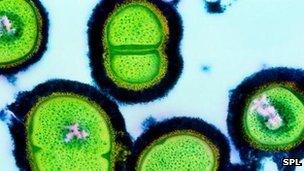Fears over risk of air transmission of superbugs
- Published

Rates of MRSA infections in the UK have been falling
The extent to which hospital superbugs are being transmitted via the air needs to be investigated, experts say.
It comes after a Leeds University study has added to a growing body of evidence about the ability of bacteria to float on air currents.
Researchers carried out lab tests on a bacteria associated with MRSA and found it could travel up to 3.5m (11ft).
And they said the findings could have implications for the design and organisation of hospitals.
The news is not surprising - it is already well established that bacteria can be transmitted this way - but the focus on MRSA bacteria has prompted calls for further work to establish how significant this could be in the fight against hospital infections.
Contamination
MRSA rates have dropped dramatically over the past decade, although in some places figures are still considered too high.
The Leeds University team believe air transmission could be a factor in some of this.
The researchers used a biological air chamber to replicate conditions in one- and two-bed hospital rooms.
They released tiny droplets containing Staphyloccus aureus, a bacteria related to MRSA, from a heated mannequin simulating the human body.
The level of contamination was highest immediately around the mannequin, but evidence was also found up to 3.5m away, the study, published in the Building and Environment journal, found.
A spokeswoman for the Health Protection Agency said while it was still thought the spread of MRSA in hospital was mainly due to direct contact, further work was needed to establish the importance of this route.
Julie Stoor, president of the Infection Prevention Society, said it was an "interesting study" that would need to be built on.
But she said it was important to remember hand hygiene was still the most effective measure in combating the spread of hospital infections.
- Published15 May 2012
- Published4 May 2012
- Published23 August 2011